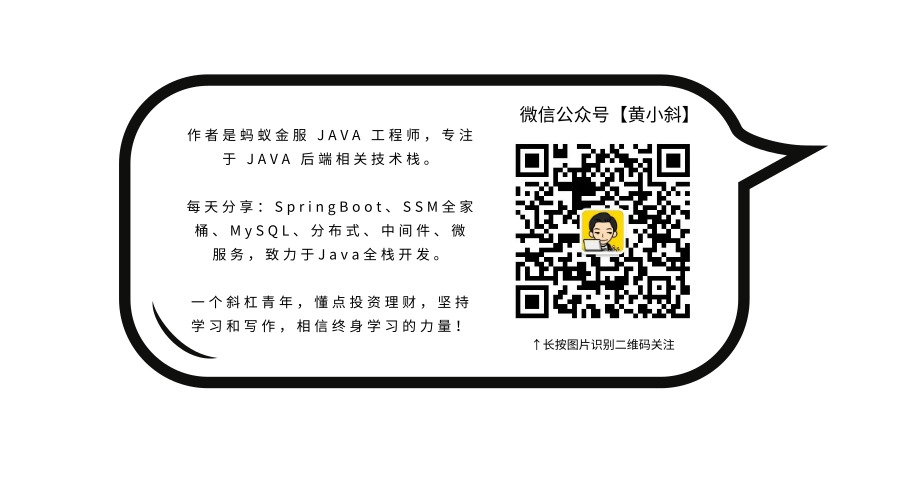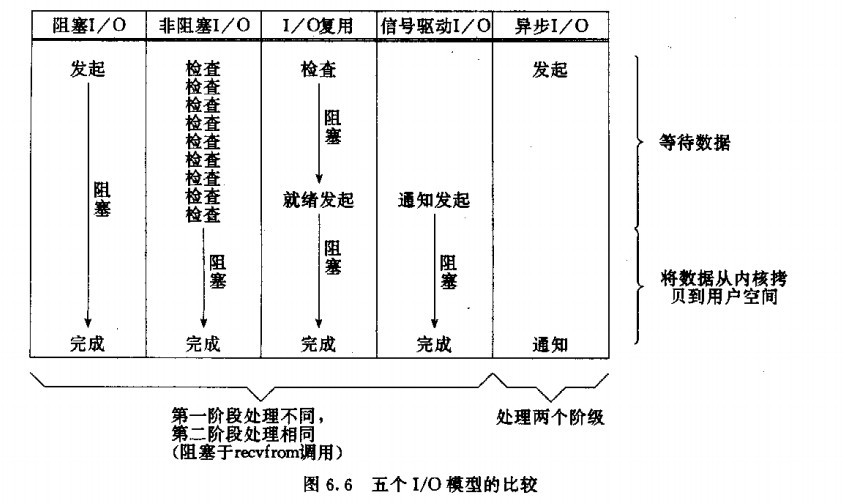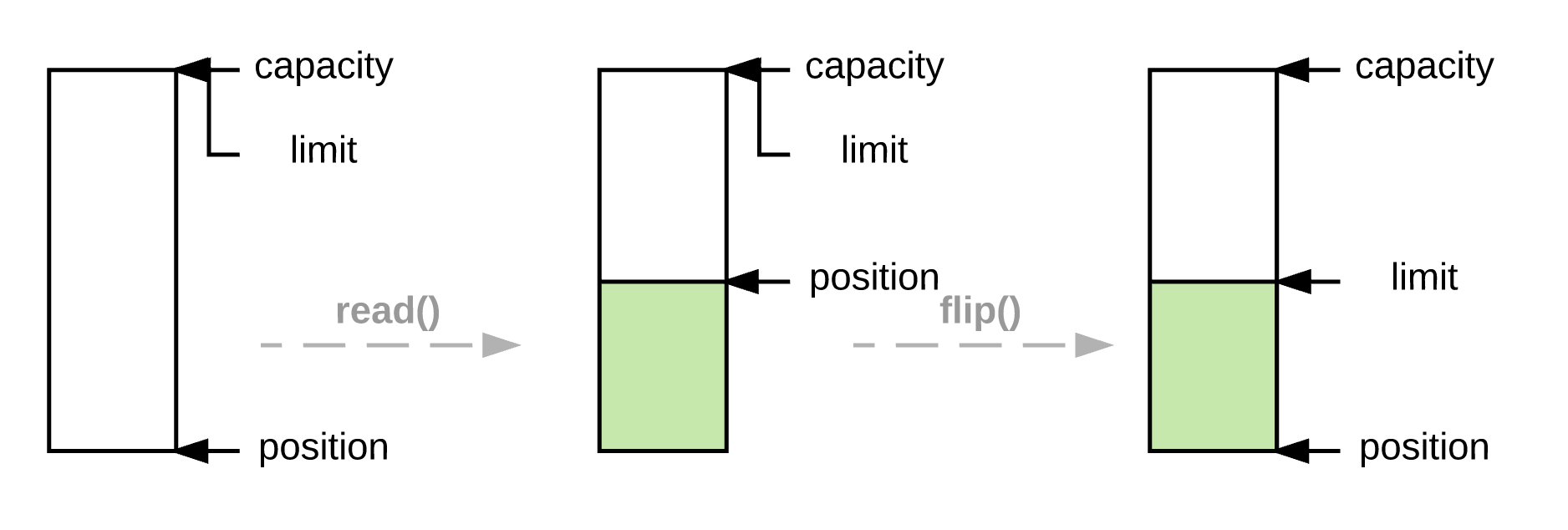Java網路程式設計與NIO詳解2:JAVA NIO 一步步構建I/O多路複用的請求模型
微信公眾號【黃小斜】作者是螞蟻金服 JAVA 工程師,專注於 JAVA 後端技術棧:SpringBoot、SSM全家桶、MySQL、分散式、中介軟體、微服務,同時也懂點投資理財,堅持學習和寫作,相信終身學習的力量!關注公眾號後回覆”架構師“即可領取 Java基礎、進階、專案和架構師等免費學習資料,更有資料庫、分散式、微服務等熱門技術學習視訊,內容豐富,兼顧原理和實踐,另外也將贈送作者原創的Java學習指南、Java程式設計師面試指南等乾貨資源。

當前環境
- jdk == 1.8
程式碼地址
git 地址:https://github.com/jasonGeng88/java-network-programming
知識點
- nio 下 I/O 阻塞與非阻塞實現
- SocketChannel 介紹
- I/O 多路複用的原理
- 事件選擇器與 SocketChannel 的關係
- 事件監聽型別
- 位元組緩衝 ByteBuffer 資料結構
場景
接著上一篇中的站點訪問問題,如果我們需要併發訪問10個不同的網站,我們該如何處理?
在上一篇中,我們使用了java.net.socket類來實現了這樣的需求,以一執行緒處理一連線的方式,並配以執行緒池的控制,貌似得到了當前的最優解。可是這裡也存在一個問題,連線處理是同步的,也就是併發數量增大後,大量請求會在佇列中等待,或直接異常丟擲。
為解決這問題,我們發現元凶處在“一執行緒一請求”上,如果一個執行緒能同時處理多個請求,那麼在高併發下效能上會大大改善。這裡就借住 JAVA 中的 nio 技術來實現這一模型。
nio 的阻塞實現
關於什麼是 nio,從字面上理解為 New IO,就是為了彌補原本 I/O 上的不足,而在 JDK 1.4 中引入的一種新的 I/O 實現方式。簡單理解,就是它提供了 I/O 的阻塞與非阻塞的兩種實現方式(當然,預設實現方式是阻塞的。)。
下面,我們先來看下 nio 以阻塞方式是如何處理的。
建立連線
有了上一篇 socket 的經驗,我們的第一步一定也是建立 socket 連線。只不過,這裡不是採用 new socket() 的方式,而是引入了一個新的概念 SocketChannel。它可以看作是 socket 的一個完善類,除了提供 Socket 的相關功能外,還提供了許多其他特性,如後面要講到的向選擇器註冊的功能。
類圖如下: 
建立連線程式碼實現:
// 初始化 socket,建立 socket 與 channel 的繫結關係 SocketChannel socketChannel = SocketChannel.open(); // 初始化遠端連線地址 SocketAddress remote = new InetSocketAddress(this.host, port); // I/O 處理設定阻塞,這也是預設的方式,可不設定 socketChannel.configureBlocking(true); // 建立連線 socketChannel.connect(remote);
獲取 socket 連線
因為是同樣是 I/O 阻塞的實現,所以後面的關於 socket 輸入輸出流的處理,和上一篇的基本相同。唯一差別是,這裡需要通過 channel 來獲取 socket 連線。
- 獲取 socket 連線
Socket socket = socketChannel.socket();
- 處理輸入輸出流
PrintWriter pw = getWriter(socketChannel.socket()); BufferedReader br = getReader(socketChannel.socket());
完整示例
package com.jason.network.mode.nio;
import com.jason.network.constant.HttpConstant;
import com.jason.network.util.HttpUtil;
import java.io.*;
import java.net.InetSocketAddress;
import java.net.Socket;
import java.net.SocketAddress;
import java.nio.channels.SocketChannel;
public class NioBlockingHttpClient {
private SocketChannel socketChannel;
private String host;
public static void main(String[] args) throws IOException {
for (String host: HttpConstant.HOSTS) {
NioBlockingHttpClient client = new NioBlockingHttpClient(host, HttpConstant.PORT);
client.request();
}
}
public NioBlockingHttpClient(String host, int port) throws IOException {
this.host = host;
socketChannel = SocketChannel.open();
socketChannel.socket().setSoTimeout(5000);
SocketAddress remote = new InetSocketAddress(this.host, port);
this.socketChannel.connect(remote);
}
public void request() throws IOException {
PrintWriter pw = getWriter(socketChannel.socket());
BufferedReader br = getReader(socketChannel.socket());
pw.write(HttpUtil.compositeRequest(host));
pw.flush();
String msg;
while ((msg = br.readLine()) != null){
System.out.println(msg);
}
}
private PrintWriter getWriter(Socket socket) throws IOException {
OutputStream out = socket.getOutputStream();
return new PrintWriter(out);
}
private BufferedReader getReader(Socket socket) throws IOException {
InputStream in = socket.getInputStream();
return new BufferedReader(new InputStreamReader(in));
}
}
nio 的非阻塞實現
原理分析
nio 的阻塞實現,基本與使用原生的 socket 類似,沒有什麼特別大的差別。
下面我們來看看它真正強大的地方。到目前為止,我們將的都是阻塞 I/O。何為阻塞 I/O,看下圖:

我們主要觀察圖中的前三種 I/O 模型,關於非同步 I/O,一般需要依靠作業系統的支援,這裡不討論。
從圖中可以發現,阻塞過程主要發生在兩個階段上:
- 第一階段:等待資料就緒;
- 第二階段:將已就緒的資料從核心緩衝區拷貝到使用者空間;
這裡產生了一個從核心到使用者空間的拷貝,主要是為了系統的效能優化考慮。假設,從網絡卡讀到的資料直接返回給使用者空間,那勢必會造成頻繁的系統中斷,因為從網絡卡讀到的資料不一定是完整的,可能斷斷續續的過來。通過核心緩衝區作為緩衝,等待緩衝區有足夠的資料,或者讀取完結後,進行一次的系統中斷,將資料返回給使用者,這樣就能避免頻繁的中斷產生。
瞭解了 I/O 阻塞的兩個階段,下面我們進入正題。看看一個執行緒是如何實現同時處理多個 I/O 呼叫的。從上圖中的非阻塞 I/O 可以看出,僅僅只有第二階段需要阻塞,第一階段的資料等待過程,我們是不需要關心的。不過該模型是頻繁地去檢查是否就緒,造成了 CPU 無效的處理,反而效果不好。如果有一種類似的好萊塢原則— “不要給我們打電話,我們會打給你” 。這樣一個執行緒可以同時發起多個 I/O 呼叫,並且不需要同步等待資料就緒。在資料就緒完成的時候,會以事件的機制,來通知我們。這樣不就實現了單執行緒同時處理多個 IO 呼叫的問題了嗎?即所說的“I/O 多路複用模型”。
廢話講了一大堆,下面就來實際操刀一下。
建立選擇器
由上面分析可以,我們得有一個選擇器,它能監聽所有的 I/O 操作,並且以事件的方式通知我們哪些 I/O 已經就緒了。
程式碼如下:
import java.nio.channels.Selector;
...
private static Selector selector;
static {
try {
selector = Selector.open();
} catch (IOException e) {
e.printStackTrace();
}
}
建立非阻塞 I/O
下面,我們來建立一個非阻塞的 SocketChannel,程式碼與阻塞實現型別,唯一不同是socketChannel.configureBlocking(false)。
注意:只有在socketChannel.configureBlocking(false)之後的程式碼,才是非阻塞的,如果socketChannel.connect()在設定非阻塞模式之前,那麼連線操作依舊是阻塞呼叫的。
SocketChannel socketChannel = SocketChannel.open(); SocketAddress remote = new InetSocketAddress(host, port); // 設定非阻塞模式 socketChannel.configureBlocking(false); socketChannel.connect(remote);
建立選擇器與 socket 的關聯
選擇器與 socket 都建立好了,下一步就是將兩者進行關聯,好讓選擇器和監聽到 Socket 的變化。這裡採用了以 SocketChannel 主動註冊到選擇器的方式進行關聯繫結,這也就解釋了,為什麼不直接new Socket(),而是以SocketChannel的方式來建立 socket。
程式碼如下:
socketChannel.register(selector,
SelectionKey.OP_CONNECT
| SelectionKey.OP_READ
| SelectionKey.OP_WRITE);
上面程式碼,我們將 socketChannel 註冊到了選擇器中,並且對它的連線、可讀、可寫事件進行了監聽。
具體的事件監聽型別如下:
| 操作型別 | 值 | 描述 | 所屬物件 |
|---|---|---|---|
| OP_READ | 1 << 0 | 讀操作 | SocketChannel |
| OP_WRITE | 1 << 2 | 寫操作 | SocketChannel |
| OP_CONNECT | 1 << 3 | 連線socket操作 | SocketChannel |
| OP_ACCEPT | 1 << 4 | 接受socket操作 | ServerSocketChannel |
選擇器監聽 socket 變化
現在,選擇器已經與我們關心的 socket 進行了關聯。下面就是感知事件的變化,然後呼叫相應的處理機制。
這裡與 Linux 下的 selector 有點不同,nio 下的 selecotr 不會去遍歷所有關聯的 socket。我們在註冊時設定了我們關心的事件型別,每次從選擇器中獲取的,只會是那些符合事件型別,並且完成就緒操作的 socket,減少了大量無效的遍歷操作。
public void select() throws IOException {
// 獲取就緒的 socket 個數
while (selector.select() > 0){
// 獲取符合的 socket 在選擇器中對應的事件控制代碼 key
Set keys = selector.selectedKeys();
// 遍歷所有的key
Iterator it = keys.iterator();
while (it.hasNext()){
// 獲取對應的 key,並從已選擇的集合中移除
SelectionKey key = (SelectionKey)it.next();
it.remove();
if (key.isConnectable()){
// 進行連線操作
connect(key);
}
else if (key.isWritable()){
// 進行寫操作
write(key);
}
else if (key.isReadable()){
// 進行讀操作
receive(key);
}
}
}
}
注意:這裡的selector.select()是同步阻塞的,等待有事件發生後,才會被喚醒。這就防止了 CPU 空轉的產生。當然,我們也可以給它設定超時時間,selector.select(long timeout)來結束阻塞過程。
處理連線就緒事件
下面,我們分別來看下,一個 socket 是如何來處理連線、寫入資料和讀取資料的(這些操作都是阻塞的過程,只是我們將等待就緒的過程變成了非阻塞的了)。
處理連線程式碼:
// SelectionKey 代表 SocketChannel 在選擇器中註冊的事件控制代碼
private void connect(SelectionKey key) throws IOException {
// 獲取事件控制代碼對應的 SocketChannel
SocketChannel channel = (SocketChannel) key.channel();
// 真正的完成 socket 連線
channel.finishConnect();
// 列印連線資訊
InetSocketAddress remote = (InetSocketAddress) channel.socket().getRemoteSocketAddress();
String host = remote.getHostName();
int port = remote.getPort();
System.out.println(String.format("訪問地址: %s:%s 連線成功!", host, port));
}
處理寫入就緒事件
// 字符集處理類
private Charset charset = Charset.forName("utf8");
private void write(SelectionKey key) throws IOException {
SocketChannel channel = (SocketChannel) key.channel();
InetSocketAddress remote = (InetSocketAddress) channel.socket().getRemoteSocketAddress();
String host = remote.getHostName();
// 獲取 HTTP 請求,同上一篇
String request = HttpUtil.compositeRequest(host);
// 向 SocketChannel 寫入事件
channel.write(charset.encode(request));
// 修改 SocketChannel 所關心的事件
key.interestOps(SelectionKey.OP_READ);
}
這裡有兩個地方需要注意:
- 第一個是使用
channel.write(charset.encode(request));進行資料寫入。有人會說,為什麼不能像上面同步阻塞那樣,通過PrintWriter包裝類進行操作。因為PrintWriter的write()方法是阻塞的,也就是說要等資料真正從 socket 傳送出去後才返回。
這與我們這裡所講的阻塞是不一致的,這裡的操作雖然也是阻塞的,但它發生的過程是在資料從使用者空間到核心緩衝區拷貝過程。至於系統將緩衝區的資料通過 socket 傳送出去,這不在阻塞範圍內。也解釋了為什麼要用 Charset 對寫入內容進行編碼了,因為緩衝區接收的格式是ByteBuffer。
第二,選擇器用來監聽事件變化的兩個引數是
interestOps與readyOps。interestOps:表示
SocketChannel所關心的事件型別,也就是告訴選擇器,當有這幾種事件發生時,才來通知我。這裡通過key.interestOps(SelectionKey.OP_READ);告訴選擇器,之後我只關心“讀就緒”事件,其他的不用通知我了。readyOps:表示
SocketChannel當前就緒的事件型別。以key.isReadable()為例,判斷依據就是:return (readyOps() & OP_READ) != 0;
處理讀取就緒事件
private void receive(SelectionKey key) throws IOException {
SocketChannel channel = (SocketChannel) key.channel();
ByteBuffer buffer = ByteBuffer.allocate(1024);
channel.read(buffer);
buffer.flip();
String receiveData = charset.decode(buffer).toString();
// 當再沒有資料可讀時,取消在選擇器中的關聯,並關閉 socket 連線
if ("".equals(receiveData)) {
key.cancel();
channel.close();
return;
}
System.out.println(receiveData);
}
這裡的處理基本與寫入一致,唯一要注意的是,這裡我們需要自行處理去緩衝區讀取資料的操作。首先會分配一個固定大小的緩衝區,然後從核心緩衝區中,拷貝資料至我們剛分配固定緩衝區上。這裡存在兩種情況:
- 我們分配的緩衝區過大,那多餘的部分以0補充(初始化時,其實會自動補0)。
- 我們分配的緩衝去過小,因為選擇器會不停的遍歷。只要
SocketChannel處理讀就緒狀態,那下一次會繼續讀取。當然,分配過小,會增加遍歷次數。
最後,將一下 ByteBuffer 的結構,它主要有 position, limit,capacity 以及 mark 屬性。以 buffer.flip(); 為例,講下各屬性的作用(mark 主要是用來標記之前 position 的位置,是在當前 postion 無法滿足的情況下使用的,這裡不作討論)。

從圖中看出,
- 容量(capacity):表示緩衝區可以儲存的資料容量;
- 極限(limit):表示緩衝區的當前終點,即寫入、讀取都不可超過該重點;
- 位置(position):表示緩衝區下一個讀寫單元的位置;
完整程式碼
package com.jason.network.mode.nio;
import com.jason.network.constant.HttpConstant;
import com.jason.network.util.HttpUtil;
import java.io.IOException;
import java.net.InetSocketAddress;
import java.net.SocketAddress;
import java.nio.ByteBuffer;
import java.nio.channels.SelectionKey;
import java.nio.channels.Selector;
import java.nio.channels.SocketChannel;
import java.nio.charset.Charset;
import java.util.Iterator;
import java.util.Set;
public class NioNonBlockingHttpClient {
private static Selector selector;
private Charset charset = Charset.forName("utf8");
static {
try {
selector = Selector.open();
} catch (IOException e) {
e.printStackTrace();
}
}
public static void main(String[] args) throws IOException {
NioNonBlockingHttpClient client = new NioNonBlockingHttpClient();
for (String host: HttpConstant.HOSTS) {
client.request(host, HttpConstant.PORT);
}
client.select();
}
public void request(String host, int port) throws IOException {
SocketChannel socketChannel = SocketChannel.open();
socketChannel.socket().setSoTimeout(5000);
SocketAddress remote = new InetSocketAddress(host, port);
socketChannel.configureBlocking(false);
socketChannel.connect(remote);
socketChannel.register(selector,
SelectionKey.OP_CONNECT
| SelectionKey.OP_READ
| SelectionKey.OP_WRITE);
}
public void select() throws IOException {
while (selector.select(500) > 0){
Set keys = selector.selectedKeys();
Iterator it = keys.iterator();
while (it.hasNext()){
SelectionKey key = (SelectionKey)it.next();
it.remove();
if (key.isConnectable()){
connect(key);
}
else if (key.isWritable()){
write(key);
}
else if (key.isReadable()){
receive(key);
}
}
}
}
private void connect(SelectionKey key) throws IOException {
SocketChannel channel = (SocketChannel) key.channel();
channel.finishConnect();
InetSocketAddress remote = (InetSocketAddress) channel.socket().getRemoteSocketAddress();
String host = remote.getHostName();
int port = remote.getPort();
System.out.println(String.format("訪問地址: %s:%s 連線成功!", host, port));
}
private void write(SelectionKey key) throws IOException {
SocketChannel channel = (SocketChannel) key.channel();
InetSocketAddress remote = (InetSocketAddress) channel.socket().getRemoteSocketAddress();
String host = remote.getHostName();
String request = HttpUtil.compositeRequest(host);
System.out.println(request);
channel.write(charset.encode(request));
key.interestOps(SelectionKey.OP_READ);
}
private void receive(SelectionKey key) throws IOException {
SocketChannel channel = (SocketChannel) key.channel();
ByteBuffer buffer = ByteBuffer.allocate(1024);
channel.read(buffer);
buffer.flip();
String receiveData = charset.decode(buffer).toString();
if ("".equals(receiveData)) {
key.cancel();
channel.close();
return;
}
System.out.println(receiveData);
}
}
示例效果

總結
本文從 nio 的阻塞方式講起,介紹了阻塞 I/O 與非阻塞 I/O 的區別,以及在 nio 下是如何一步步構建一個 IO 多路複用的模型的客戶端。文中需要理解的內容比較多,如果有理解錯誤的地方,歡迎指正~
補充1:基於NIO的多路複用客戶端(執行緒池版)
public static void main(String[] args) {
基於執行緒池的偽非同步NIO模型 a = new 基於執行緒池的偽非同步NIO模型();
a.startServer(); }
private Charset charset = Charset.forName("utf8"); class WriteThread implements Runnable {
private SelectionKey key;
public WriteThread(SelectionKey key) {
this.key = key;
}
@Override
public void run() {
SocketChannel socketChannel = (SocketChannel) key.channel();
Socket socket = socketChannel.socket();
try {
socketChannel.finishConnect();
} catch (IOException e) {
e.printStackTrace();
}
InetSocketAddress remote = (InetSocketAddress) socketChannel.socket().getRemoteSocketAddress();
String host = remote.getHostName();
int port = remote.getPort();
System._out_.println(String.format("訪問地址: %s:%s 連線成功!", host, port)); }
}
class ReadThread implements Runnable {
private SelectionKey key;
public ReadThread(SelectionKey key) {
this.key = key;
}
@Override
public void run() {
SocketChannel socketChannel = (SocketChannel) key.channel();
ByteBuffer buffer = ByteBuffer.allocate(1024);
try {
socketChannel.read(buffer);
} catch (IOException e) {
e.printStackTrace();
}
buffer.flip();
String receiveData = null;
try {
receiveData = new String(buffer.array(), "utf8");
} catch (UnsupportedEncodingException e) {
e.printStackTrace();
}
if ("".equals(receiveData)) {
key.cancel();
try {
socketChannel.close();
} catch (IOException e) {
e.printStackTrace();
}
return;
}
System._out_.println(receiveData);
}
}
class ConnectThread implements Runnable {
private SelectionKey key;
public ConnectThread(SelectionKey key) {
this.key = key;
}
@Override
public void run() {
SocketChannel socketChannel = (SocketChannel) key.channel();
ByteBuffer byteBuffer = charset.encode("hello world");
try {
socketChannel.write(byteBuffer);
System._out_.println("hello world");
} catch (IOException e) {
e.printStackTrace();
}
key.interestOps(SelectionKey._OP_READ_);
}
}
public void startServer() {
ExecutorService executorService = Executors.newFixedThreadPool(10);
try {
SocketChannel socketChannel = SocketChannel.open();
Selector selector = Selector.open(); socketChannel.configureBlocking(false);
InetSocketAddress inetAddress = new InetSocketAddress(1234); socketChannel.connect(inetAddress);
socketChannel.register(selector, SelectionKey._OP_CONNECT_ |
SelectionKey._OP_READ_ |
SelectionKey._OP_WRITE_); while (selector.select(500) > 0) {
Iterator
補充2:基於NIO的多路複用服務端
class NioNonBlockingHttpServer {
private static Selector _selector_;
private Charset charset = Charset.forName("utf8"); static {
try {
_selector_ = Selector.open();
} catch (IOException e) {
e.printStackTrace();
}
}
public static void main(String[] args) throws IOException {
NioNonBlockingHttpServer httpServer = new NioNonBlockingHttpServer();
httpServer.select(); }
public void request(int port) throws IOException {
ServerSocketChannel serverSocketChannel = ServerSocketChannel.open();
serverSocketChannel.socket().setSoTimeout(5000);
serverSocketChannel.configureBlocking(false);
serverSocketChannel.socket().bind(new InetSocketAddress(8383)); // serverSocketChannel.register(selector, // SelectionKey.OP_CONNECT // | SelectionKey.OP_READ // | SelectionKey.OP_WRITE);
}
public void select() throws IOException {
while (_selector_.select(500) > 0) {
Set keys = _selector_.selectedKeys(); Iterator it = keys.iterator(); while (it.hasNext()) {
SelectionKey key = (SelectionKey) it.next();
it.remove(); if (key.isAcceptable()) {
accept(key);
} else if (key.isWritable()) {
write(key);
} else if (key.isReadable()) {
receive(key);
}
}
}
}
private void accept(SelectionKey key) throws IOException {
SocketChannel socketChannel;
ServerSocketChannel channel = (ServerSocketChannel) key.channel();
socketChannel = channel.accept();//接受連線請求
socketChannel.configureBlocking(false); socketChannel.register(_selector_, SelectionKey._OP_READ_ | SelectionKey._OP_WRITE_); InetSocketAddress local = (InetSocketAddress) channel.socket().getLocalSocketAddress();
String host = local.getHostName();
int port = local.getPort();
System._out_.println(String.format("請求地址: %s:%s 接收成功!", host, port)); }
private void write(SelectionKey key) throws IOException {
SocketChannel channel = (SocketChannel) key.channel(); InetSocketAddress local = (InetSocketAddress) channel.socket().getRemoteSocketAddress();
String host = local.getHostName();
String msg = "hello Client";
channel.write(charset.encode(msg)); System._out_.println(msg);
key.interestOps(SelectionKey._OP_READ_);
}
private void receive(SelectionKey key) throws IOException {
SocketChannel channel = (SocketChannel) key.channel();
ByteBuffer buffer = ByteBuffer.allocate(1024);
channel.read(buffer);
buffer.flip();
String receiveData = charset.decode(buffer).toString(); if ("".equals(receiveData)) {
key.cancel();
channel.close();
return; }
System._out_.println(receiveData);
}
